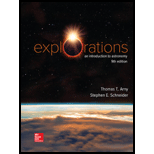
Concept explainers
(1)
The diameter of pupil of human eye needed to see the same resolution in the infrared at wavelength of
(1)
Answer to Problem 5P
The diameter of pupil of human eye needed to see the same resolution in the infrared at wavelength of
Explanation of Solution
The diameter of pupil of human eye is
Write the expression for angle of separation between two objects according to the criterion for resolution.
Here,
Since the person need to see the same resolution in the infrared as in visible the angle of separation in both region of light can be equated.
Using equation (I), equation (II) can be modified as,
Solve equation (III) for
Conclusion:
Substitute,
Therefore, the diameter of pupil of human eye needed to see the same resolution in the infrared at wavelength of
(2)
The diameter of pupil of human eye needed to see the same resolution in the radio at wavelength of
(2)
Answer to Problem 5P
The diameter of pupil of human eye needed to see the same resolution in the radio at wavelength of
Explanation of Solution
The diameter of pupil of human eye is
Since the person need to see the same resolution in the radio as in visible the angle of separation in both region of light can be equated.
Similar to equation (III) it can be written for the visible and radio wave lights as,
Solve equation (VI) for
Conclusion:
Substitute,
Therefore, the diameter of pupil of human eye needed to see the same resolution in the radio at wavelength of
Want to see more full solutions like this?
Chapter 5 Solutions
EXPLORATIONS:INTRO.TO ASTRONOMY
- In broad daylight, the size of your pupil is typically 3 mm. In dark situations, it expands to about 7 mm. How much more light can it gather?arrow_forwardHow much more light can be gathered by a telescope that is 8 m in diameter than by your fully dark-adapted eye at 7 mm?arrow_forwardWhat would be the properties of an ideal astronomical detector? How closely do the actual properties of a CCD approach this ideal?arrow_forward
- How does human vision's peak in color sensitivity relate to the Sun? Why can't long-wavelength radio observations be made from Earth's surface?arrow_forwardAstronauts observing from a space station need a telescope with a resolving power of 0.6 arc second at a wavelength of 530 nm and a magnifying power of 220. Design a telescope to meet their needs. (State the necessary primary diameter of the telescope, in m, and the ratio of the focal lengths below.) What will its light-gathering power be, compared with a dark-adapted human eye? (Assume that the pupil of your eye can open to a diameter of about 0.8 cm in dark conditions.)arrow_forwardAstronauts observing from a space station need a telescope with a resolving power of 0.6 arc second at a wavelength of 530 nm and a magnifying power of 220. Design a telescope to meet their needs.What will its light-gathering power be, compared with a dark-adapted human eye? (Assume that the pupil of your eye can open to a diameter of about 0.8 cm in dark conditions.)(State the necessary primary diameter of the telescope, in m, and the ratio of the focal lengths below.)arrow_forward
- How does resolution and hysteresis affect accuracy?arrow_forwardHow does the resolving power of a 9 m telescope compare with that of a hubble space telescope?arrow_forwardWhat is the approximate diffraction limit in arc second, of a 99 meter diameter radio telescope observing 23cm radiation ?arrow_forward

 Stars and Galaxies (MindTap Course List)PhysicsISBN:9781337399944Author:Michael A. SeedsPublisher:Cengage Learning
Stars and Galaxies (MindTap Course List)PhysicsISBN:9781337399944Author:Michael A. SeedsPublisher:Cengage Learning Foundations of Astronomy (MindTap Course List)PhysicsISBN:9781337399920Author:Michael A. Seeds, Dana BackmanPublisher:Cengage Learning
Foundations of Astronomy (MindTap Course List)PhysicsISBN:9781337399920Author:Michael A. Seeds, Dana BackmanPublisher:Cengage Learning AstronomyPhysicsISBN:9781938168284Author:Andrew Fraknoi; David Morrison; Sidney C. WolffPublisher:OpenStax
AstronomyPhysicsISBN:9781938168284Author:Andrew Fraknoi; David Morrison; Sidney C. WolffPublisher:OpenStax Stars and GalaxiesPhysicsISBN:9781305120785Author:Michael A. Seeds, Dana BackmanPublisher:Cengage Learning
Stars and GalaxiesPhysicsISBN:9781305120785Author:Michael A. Seeds, Dana BackmanPublisher:Cengage Learning





